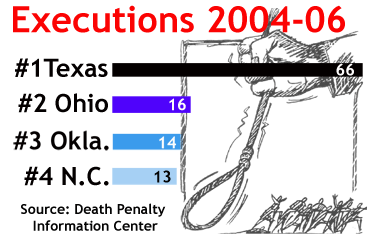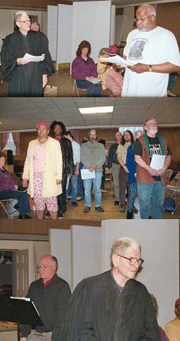| Educational Resources Educators, practioners and activists are invited to contribute materials and strategies for teaching about prisons, prisoner rehabilitation and alternatives to incarceration. Please submit your guest column, syllabi, lesson plans, or web links to “Educational Resource” (written in the subject line):
[email protected]
Syllabi and Course Material:
Activist Learning
Anti-Prison Resources for Students (SPAN)
Cultural Resistance: The Role of Arts Social Justice Movements (Laurent Alfred)
Defending Justice: An Activist Resource Kit (Political Research Associates)
Education Not Incarceration Curriculum Page (Education Not Incarceration)
Ex-Prisoner Resource Page (Critical Resistance)
SOCIAL JUSTICE (Shawn Nolan)
Tookie Williams’ Protocol for Peace, and other essays
WHAT KIDS ARE REALLY LEARNING IN SCHOOL
(By Mumia Abu-Jamal)
Anthropology
Danger and Disorder: An Anthropology of Crime (Ellen Moodie)
Identity and Difference (Social Control lecture, Silbey)
Criminal Justice
Alternatives to Incarceration (Cecil Greek)
CRM 331: CORRECTIONS (P. S. Leighton)
Human Rights Training for Prison Officials (UN Manual)
Saving Futures, Saving Dollars: The Impact of Education on Crime Reduction and Earnings (The Alliance for Excellent Education)
History
Defending Justice: An Activist Resource Kit (Political Research Associates) Journalism
Covering Criminal Justice. A resource guide for reporters and editors. Volume 1. (Columbia Journalism Review)
Covering Criminal Justice, Vol. 2. (Columbia Journalism Review)
OPEN PRISONS (SPJs guide to state policies governing media access to correctional facilities) Law
Constitutional Law of Incarceration (Margo Schlanger)
The Innocence Project (Benjamin Cardozo School of Law) Psychology
The Stanford Prison Experiment Religion
Catholic Social Teachings and the Prison System
Doing Time, Doing Vipassana (meditation in Indian prisons) Sociology
JUVENILE DELINQUENCY (Sandra Way)
Model Prison: Simulation in a Corrections Class
Prisons: Do they Work? (UK teaching resource)
Sociology of Delinquency (Patricia Masters)
Educational Films
Attica: Roots of Resistance. Directed by Ashley Hunt, 2001.
Brother’s Keeper. The story of the alleged murder in June 1990 of 64-year-old Bill Ward by his brother Delbert, 59.
A Concert Behind Prison Walls (Johnny Cash) was filmed at Tennessee State Prison in 1976 with Linda Ronstadt, Roy Clark, and Foster Brooks.
Corrections (private prisons). Directed by Ashley Hunt, 2001.
Doing Time, Doing Vipassana (meditation programs in Indian prisons) by Karuna Films.
The Farm: Inside Angola State Prison in Louisiana. 1998.
Juvies (the shocking reality of juvenile offenders in America), A Chance Film Documentary, 2004.
Lock Up / Lock Down. Discovery Channel. Films for the Humanities & Sciences, 2002.
The Last Graduation (The end of college programs for prisoners). Directed by Barbara Zahm, 1998.
Mister Death: The Rise and Fall of Fred A. Leuchter, Jr. Errol Morris tells the story of Leutcher, who became an expert on executions after he helped fix the electric chair used in North Carolina. The film takes a twist when Leuchter visits Auschwitz and concludes that the Holocaust did not occur.
Mumia Abu-Jamal: A Case For Reasonable Doubt? HBO Special on Mumias case, 1996.
Real Time: A Youth Prison Documentary (minors in a California youth prison create two short films). National Film Network, 2003.
Thin Blue Line (The story of Randall Adams). Directed by Errol Morris, 1988.
This Black Soil: A Story of Resistance And Rebirth (Chronicles of a rural African-American community that defeated the state’s plans to build a prison in its backyard), Bullfrog Productions, 2004.
The Prison-Industrial Complex. An interview with Mumia Abu-Jamal by Monica Moorehead and Larry Holmes (https://www.peoplesvideo.org)
USA, INCarcerated, published by Public Media Network (https://www.videoactivism.org) 
“Lucasville” in the News
 The two-hour play begins in the prison during the riots and ends in the courtrooms, when five men — Jason Robb, George Skatzes, James Were, Carlos Sanders and Keith LaMar — are convicted. In it, the authors accuse a key informant, Anthony Lavelle, of killing Vallandingham with members of his gang. Lavelles testimony eventually convicted Robb, Skatzes, Were and Sanders of that killing. The two-hour play begins in the prison during the riots and ends in the courtrooms, when five men — Jason Robb, George Skatzes, James Were, Carlos Sanders and Keith LaMar — are convicted. In it, the authors accuse a key informant, Anthony Lavelle, of killing Vallandingham with members of his gang. Lavelles testimony eventually convicted Robb, Skatzes, Were and Sanders of that killing.
The Cleveland Plain Dealer
Lynd got some powerful ammunition to back up his criticism of the prosecution –most notably the recantations of two Lucasville inmates whose testimonies the state used to convict some of the riot leaders of murder. Both witnesses now say the prisoners they took the stand against are innocent and that they testified to the contrary only because prosecutors pressured them to do so.
The Columbus Other Paper  Staughton Lynd on Amy Goodman’s Democracy Now! Staughton Lynd on Amy Goodman’s Democracy Now!
Nine prisoners and a hostage officer were killed. A surrender was negotiated, and no sooner was the surrender negotiated with various prisoner spokespersons than the state of Ohio turned around and began to build death penalty cases against those very leaders and spokespersons. They didnt care who had really done things. They wanted to nail the leaders so that no prisoner would ever have this idea again Prisonersolidarity IN THE NEWS
WBAI, New York – 99.5 FM Pacifica Radio
Radio journalist Mimi Rosenberg read Daniel McCauley’s Prisonersolidarity essay in a show that was dedicated to his memory, which focused on youth incarceration, rehabilitation, prison reform, and the inhumane conditions at supermax prisons (a comparison is made between Youngstown’s Ohio State Penitentiary and Guantanamo). The interviewed guests were Staughton and Alice Lynd. Rosenberg’s report aired on WBAI New York, on the nationally syndicated morning show, “Wakeup Call.” You may listen to and download the interview at WBAI’s program archive: It is the June 6, 7 a.m. “Wakeup Call.” – Prisonersolidarity.org | | An Anthropological Perspective
Crime in Cross-Cultural Perspective
Anthropology in prison: Negotiating consent and accountability with a “captured” population, James Waldram
The Liberian Kpelle Moot, James Gibbs [PDF]
The Cultural Lives of Capital Punishment: Comparative Perspectives. Edited by Austin Sarat and Christian Boulanger
The End of Welfare as We Know It,Victoria Malkin (an analysis of the judicial ‘tough on crime’ ideology) [PDF]
Toward an Anthropology of Prisons, Lorna Rhodes [PDF]
The History of Solitary Confinement
The Quaker Experiment at Eastern State Penitentiary in Philadelphia, Mike Walsh
Solitary Confinement – History, effects, ideology, and practices 1770-2005, Peter Scharff Smith Prison Alternatives
Alternatives to Prison: Rethinking Crime and Punishment Briefing Paper
The Andrew Glover Youth Program
The Appearance Assistance Program: An Alternative to
Detention for Noncitizens in U.S. Immigration Removal Proceedings
Cost-benefits of Alternatives to Incarceration (Washington State Institute for Public Policy)
Education Not Incarceration Curriculum Page (Education Not Incarceration)
Instead of Prisons: A Handbook for Abolitionists (Mark Morris, Prison Research Education Action Project)
Prison Design Boycott Campaign: It’s Time to Stop Building Prisons
The National Center on Institutions and Alternatives (NCIA)
Saving Futures, Saving Dollars: The Impact of Education on Crime Reduction and Earnings (The Alliance for Excellent Education) Reading Materials
Prisonersolidarity.org Reading List
Comic Books from the Real Cost of Prisons Project. Books are sent free of charge to organizations who submit a one page explaining how you will use the comic books in your organizing, community education and outreach work.
Cost of the Death Penalty (Testimony of the Death Penalty Information Center’s Richard Dieter before Colorado House Committee), 2007
Criminal Justice Press (publisher with a restorative justice focus)
Defending Justice: An Activist Resource Kit (Political Research Associates)
Forecasting Americas Prison Population 2007-2011 (Pew Charitable Trusts Public Safety, Public Spending, 2007)
Instead of Prisons: A Handbook for Abolitionists (Mark Morris, Prison Research Education Action Project)
Lethal Injection for Execution: Chemical Asphyxiation?
Zimmer et. al. Public Library of Science (PLoS), Med 4(4): e156 (2007)
The Lethal Injection Quandary: How Medicine Has Dismantled the Death Penalty (By Deborah W. Denno, Fordham Legal Studies, May 1, 2007)
Life After Life. A Successful Return to Society (By Kunta Kenyatta, a former Ohio prisoner, 2006)
Waterside Press (criminal justice and penal affairs – a radical view of penal change). Bibliography
General Nonfiction
Alcatraz: A definitive history of the penitentiary years. Michael Esslinger provides a very readable narrative that blends a journalistic balance along with a skilled historian’s ability to bring a rich depth into this history.
(Ocean View Publishing, 2003).
The American Indian In the White Man’s Prisons: A collective statement of Native American prisoners, former prisoners, and spiritual leaders, edited by Little Rock Reed. (Reed, Uncompromising Books [P.O. Box 1760, Taos, New Mexico, 87571], 1993.)
Behind the Razor Wire: A Portrait of a Contemporary Prison. (Michael Jacobson-Hardy: New York University Press, 1999).
Capitalist Punishment: Prison Privitization and Human Rights. (Neufield, Campbell, and Coyle (editors), Clarity Press, 2003.)
Celling of America: Daniel Burton-Rose, Daniel Pens, and Paul Wright have collected reports from America’s prisons, many of which ran in Prison Legal News.
Discpline and Punish: The birth of a prison. Michael Foucault examines the history of punishment in France and Britain, and role of prisons in society. (Foucalt, Vintage Books, 1995 ed.)
Going Up the River: Pulitizer Prize winner Joseph Hallinan delivers a clear-eyed, sleekly written and deeply disturbing tour of the privatized prison landscape of America.
Hard Time Blues: How politics built a prison nation. Journalist Sasha Abramsky believes America’s exploding prison population is a fatal threat to civil society. (Abramsky, Dunne Books, 2002.)
Jailhouse Journalism: The Fouth Estate behind bars. A history of prison journalism from the beginnings of the 18th century to the ground-breaking work of Louisiana’s Angloite.
Life in Prison: Stanley “Tookie” Williams is a founder of Crips and a prisoner on California’s death row. This book is a harsh, realistic look at prison life, written for children up to fourth grade. (Hazeldon Books, 1999.)
Lockdown America: Police and prisons in the age of crisis. Christian Parenti’s study of the prison buildup of the last 15 years. Parenti makes clear that prisons are about everything but individual reform. See the review from The Nation. (Verso Press, 1999.)
Lucasville: The Untold Story of a Prison Uprising (Staughton Lynd: Temple University Press, 2004).
Newjack: Guarding Sing Sing. Journalist Ted Conover became a corectional officer in order to write the inside story.(Random House, 2000.)
Oxford History of the Prison: A scholarly and thorough work about the practice of punishment in Western society. (Norval Morris and David Rothman, eds., Oxford University Press, 1995)
Prison Nation: The warehousing of America’s poor. Written by prisoners, social critics, and luminaries of investigative reporting, this book examines the state of prison conditions and prisoners’ political concerns. (Paul Wright and Tara Herivel (editors), Routledge, 2003.)
Prison Madness: The plight of mentally ill prisoners told by a psychiatrist with extensive experience in large class-action suits challenging mental health care inside prison systems. (Terry Kupers, Jossey-Bass Press, 1999)
Race to Incarcerate: Marc Mauer charts the explosive growth of prisons and the trend toward lengthening sentences. ( New Press, 1999.)
Sensible Justice: Alternatives to Prison. David Anderson explores creative solutions some states and cities nationwide have devised to tackle the prison problem, and confronts many of the myths that have been believed about alternative sentencing. (New Press, 1998.)
Total Confinement: Madness and Reason in the Maximum Security Prison. (Lorna A. Rhodes: University of California Press, 2004).
Women in Prison: A Reference Handbook. Cyndi Banks investigates women’s incarceration, from the first women-only prison to modern state-of-the-art facilities. (ABC-CLIO, 2003.) The Death Penalty
All Things Censored: Mumia Abu-Jama from Pennsylvania’s death row. This book and CD Rom presents a collection of his writings, including essays that were banned from National Public Radio. (Seven Stories Press, 2000.)
Beyond Repair?: America’s Death Penalty. An indispensable guide to legal system’s inability to administer the death penalty fairly. (Stephen Garvey (editor). Duke University Press, 2003.)
Dead Man Walking: Helen Prejean’s eyewitness account of the death penalty. A powerful book that describes her experiences in meeting people on death row. (Vintage Books, 1997.)
Death Blossoms: Reflections of a Prisoner of Conscience. Writings by Mumia Abu-Jamal from Pennsylvania’s death row. (Plough Publishing House, 1997.)
Death Penalty Cases: Leading U.S. Supreme Court cases on capital punishment (through 2002), edited and analyzed by Barry Latzer. (Latzer, Butterworth-Heinemann, 2002 (2d Ed.).)
Executioner’s Song: Norman Mailer’s classic work on Gary Gilmore, who was the first person executed after the death penalty resumed in the United States. A powerful, evocative book. (Vintage Books, 1998.)
Execution In the Family: One son’s journey. Robert Meeropol was six years old when his parents Ethel and Julius Rosenberg were executed for conspiracy to commit espionage in 1953. ( St. Martins Press, 2003.)
Justice Denied: Examines the clemency process, the final hope for death row prisoners. Cathleen Burnett probes the decision-making process and uncovers a trail of injustice. (Burnett, Northeastern Univ. Press, June 2002.)
Killing Time: Investigative journalist Dave Lindorf takes on the case of Mumia Abu Jamal. Regardless of where one stands on the controversial case, Lindorf offers compelling information that will challenge the reader. (Common Courage Press, 2002)
The Promise of Justice: An eighteen-year fight to save four innocent men in Illinois, which culminated with ther release after a journalism professor and his students uncovering evidence of their innocence. (Protess, Warden, and Warden, Hyperion Press, 1998.)
The Wrong Men: America’s Epidemic of Wrongful Death-Row Convictions. Stanley Cohen examines some 100 instances where people sentenced to death were later exonerated, most of them ultimately proven innocent of the crimes for which they were condemned. (Cohen, Carroll & Graf, 2003.) |